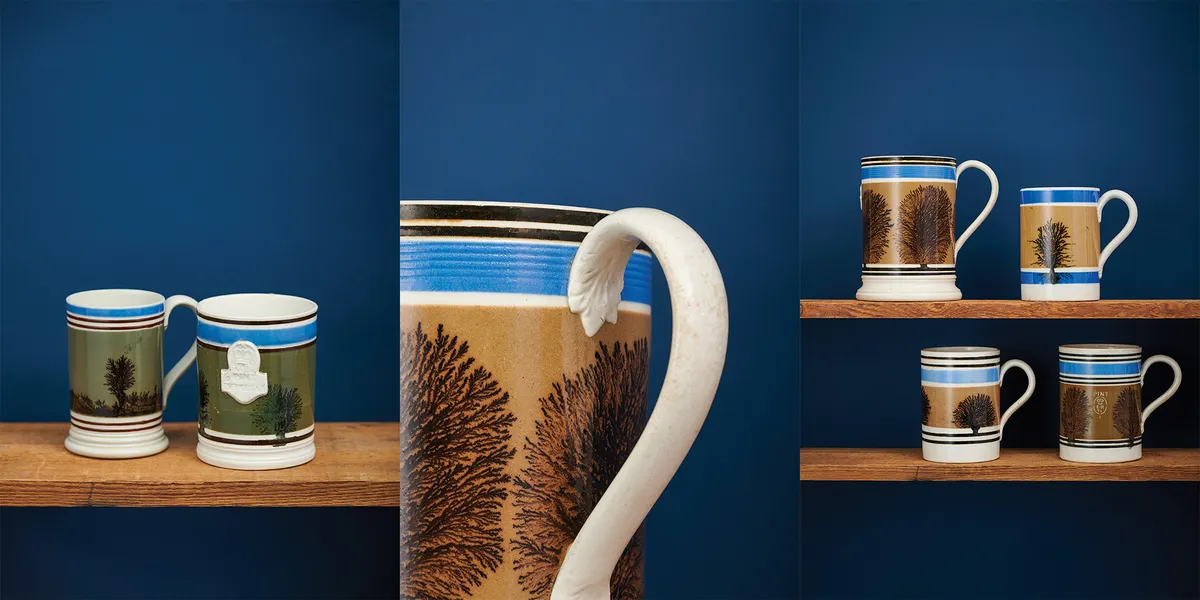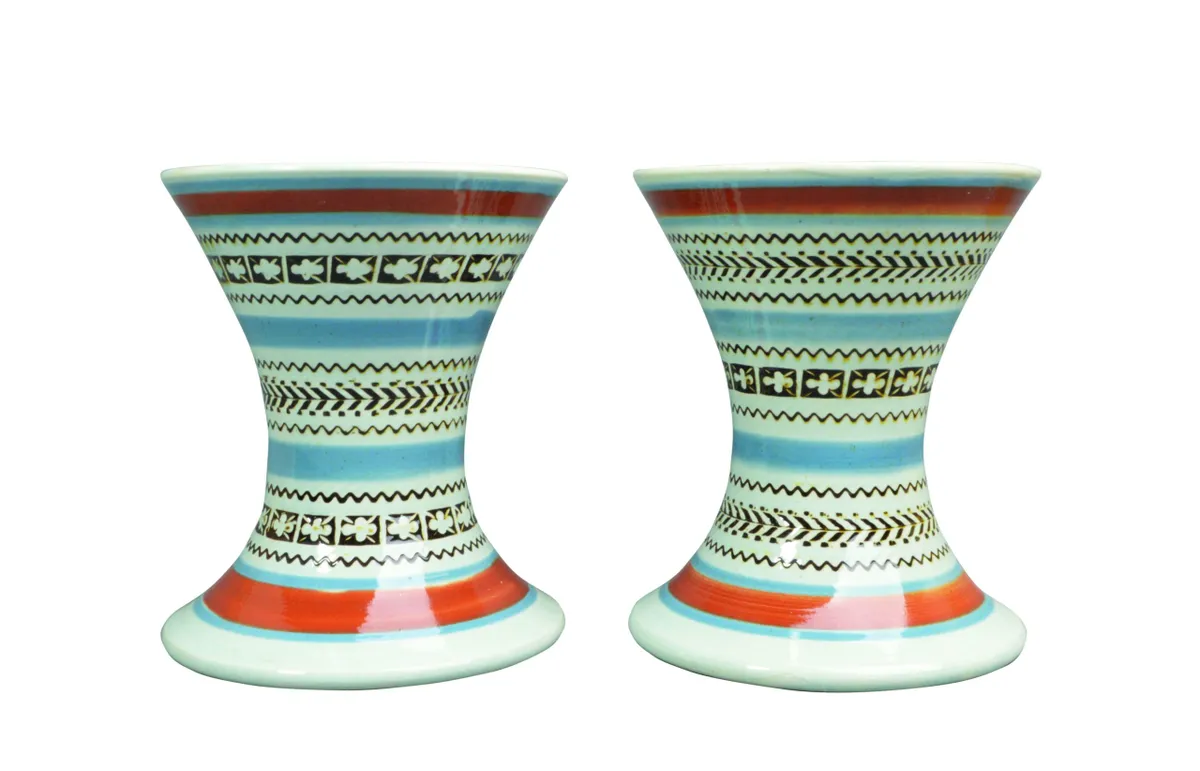Once vessels found only in pubs and taverns, mochaware ceramics have risen through the ranks to become a lively and lucrative collecting field. Hailing from Stoke-on-Trent, but created all over Britain, here’s why these unsung heroes of the ceramics world are still popular with modern-day buyers…
Made for the people
From mottled, watercolour designs reminiscent of seaweed or trees, to concentric rings of abstract shapes, mochaware pieces are happily both collectable and affordable. ‘Each and every piece of mochaware is handmade and unique,’ muses antiques dealer Sam White of Cunningham White’s in Totnes, who has a penchant for all things mocha. ‘It is evocative of ancient country taverns with aged settles, cricket tables and old gents smoking long pipes.’

Although the inventor of mochaware is unknown, the earliest surviving pieces date from around 1800 (give or take a few years) and originated in Stoke, though items were produced across Britain, France and America. They were practical and sturdy ceramic vessels that were affordable to buy, and made for day-to-day activities such as supping ale or cider. ‘The connection to everyday lives still appeals to people today,’ explains Sam. ‘There’s nothing aloof or elitist about mochaware: it’s simple, utilitarian, workaday ware.’

How is mochaware made?
Behind the Designs
‘There are the more common types of mochaware, with the tree or fernlike ‘dendritic’ pattern, often on a white background with blue and beige bandings,’ says Sam. ‘And there are fanciful names given to the other designs – looping earthworm or cat’s eyes, which describe the way the designs look.’

Each unique pattern is created by touching or dripping an acidic ‘tea’ solution onto the wet slip of a mug, tankard or other vessel. This ‘tea’, however, is unlike the standard cup of char one might drink in the afternoon. A complicated concoction of tobacco juice, stale urine, turpentine and sometimes vinegar, it causes a reaction with the alkaline slip, which creates the unusual tree-like patterns.
The designs are called mochaware because they resemble the patterns found in moss agate, a semi-precious gemstone formed from silicon dioxide, which was exported in large numbers from the port city of Mocha in Yemen. A port better known for its export of coffee!
The evolution of striped ceramics
1750sThe bread and butter of early English ceramics, spongeware often includes concentric rings of sponged designs.

1800sAll mochaware features bands of coloured stripes, the earliest surviving examples of which date from 1800.

1924Produced by TG Green, Cornishware, with its bands of blue, is perhaps the most iconic striped kitchen ceramic.

1930sFeaturing vivid rings of red, orange and black, designs by Clarice Cliff brought striped ceramics to the art deco era.

2020Stripes are timeless and, thanks to the recent trend for artisan ceramics, pieces that combine the two are going nowhere.

2 ways to style mochaware in your home
1
Traditional touches
In Rory Young’s sympathetically renovated home, a large collection of Victorian mochaware, in size order, takes pride of place above a striking red Aga and a hand-built chimneypiece.

2
Blooming lovely
Here, interior designer Carlos Sánchez-García has created a springtime display by filling an antique mocha mug with a pink-hued posy of sweet peas. The earthy colours and style of the mochaware keeps the look classic and grounded.

What to look out for when buying mochaware
Easy to come across in antiques shops or at flea markets, mochaware can be an affordable and rewarding collecting field. But how easy is it to date an item, and how can you tell when the price is right?
Holding pattern
The most common types of mochaware are those with the traditional tree-like pattern on a white background with blue and beige bands. ‘Any variations from this traditional design are more collectable and will often fetch more money,’ explains Sam White. ‘Larger pieces are also worth more, as fewer of them were made.’
Like this? You may also like...
Age is another factor that can affect value. Although mocha dates from the 1700s, it was made in vast quantities in the 20th century. ‘Pieces are seldom marked by their maker, so look for any ‘excise’ marks, especially on mugs and tankards,’ says Sam. ‘These marks were used to show what capacity the vessel could hold – quart, pint or half-pint. A rough idea of the date of manufacture can be gained from these as they have the monarch’s initials on them,’ Sam continues. ‘For example, ’VR’ would mean the piece was Victorian.’
However, manufacturers only began to register their designs from around the 1830s onwards, so don’t expect to find marks on all examples of mochaware.
Condition is key
Expect to pay upwards of £1,000 for an old piece of mochaware in mint condition – any chips or cracks will decrease the value. ‘Personally, I don’t mind chips, as these pieces were made to be used and abused,’ says Sam. ‘Some of my favourite pieces of mochaware are endearingly referred to as ‘make-do-and-mend ware’, as they had been repaired by their previous owners.’ Pieces of this nature, and other small examples, can be bought for around £40-£50.
Shop the look - other mochaware for your home
Victorian mochaware tankard, £165, Cunningham White’s.

Mochaware preserve pot, £17.95, Davids Old Stuff at Etsy.

Antique mocha piggy bank, £59.99, No Empty Shelf at Etsy.

Pearlware pottery mocha table salt c1830, £350, Martyn Edgell Antiques.

Antique mochaware pottery mug, £280, The Antique Dispensary.

Mochaware spill vases c1830, £950, Martyn Edgell Antiques.

